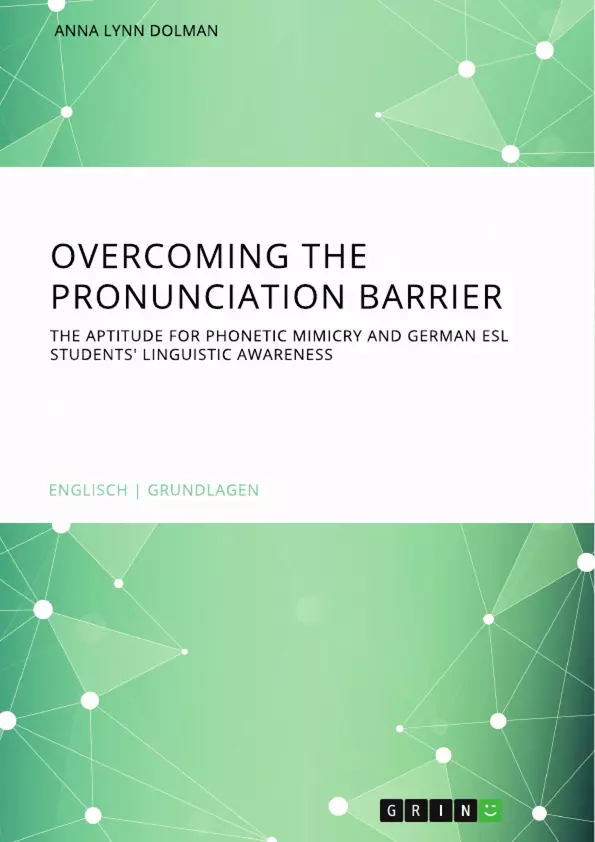This paper firstly compares and contrasts the phonetic and phonological systems of English and German and then goes on to describe some frequently occurring problems concerning pronunciation and non-native accents of German ESL students. Some of the factors leading to the problems that will be scrutinized are interference of German, learners’ attitudes and insufficient knowledge of phonetics and phonology systems of the English language, among others.
Moreover, the concept of what is commonly referred to as the aptitude for (phonetic) mimicry will be illuminated and discussed from different viewpoints, taking into account the origin of the term and its applicability to linguistics, particularly within the fields of phonetics and phonology.
One of the objectives of this paper will thus be to determine possible factors affecting learners’ pronunciation competence and to examine to what extent formal instruction in phonetics and phonology can alleviate certain pronunciation difficulties. To that end, a small-scale study was designed and conducted at the University of Cologne with first- and second-year English students, five of whom had not yet taken the Practical Phonetics & Phonology (PPP) course that forms an obligatory part of the English Studies Bachelor’s Degree Program and five who had taken it during the previous semester and had passed the end-of-module exam.
Table of Contents
- INTRODUCTION
- THEORETICAL BACKGROUND
- THE ENGLISH AND GERMAN PHONETIC AND PHONOLOGICAL SYSTEMS COMPARED
- COMMON ERRORS AND POTENTIAL MISUNDERSTANDINGS
- THE APTITUDE FOR PHONETIC MIMICRY
- MIMICRY AS AN INTERDISCIPLINARY PHENOMENON
- INNATE OR ACQUIRED? A DECADES-LONG DEBATE
- EMPIRICAL RESEARCH AND TEACHING APPROACHES
- PARTICIPANTS AND DESIGN OF THE SMALL-SCALE STUDY
- EVALUATION OF THE RESULTS
- TEACHING PRONUNCIATION: SHIFTS IN EDUCATIONAL TRENDS
- CONCLUSION
Objectives and Key Themes
This paper aims to examine the difficulties faced by native German speakers when learning to pronounce English, specifically focusing on phonetic mimicry and the role of formal instruction in phonetics and phonology. The paper explores the theoretical background of language acquisition and investigates the potential influence of innate abilities and educational interventions on pronunciation accuracy.
- The impact of cross-linguistic differences between English and German on pronunciation
- The concept of phonetic mimicry and its relevance to foreign language learning
- The role of formal instruction in phonetics and phonology in improving pronunciation
- The influence of learner motivation and language awareness on pronunciation development
- The ongoing debate regarding the innateness of language aptitude
Chapter Summaries
- Introduction: The introduction sets the stage by discussing the importance of pronunciation in language acquisition and the challenges faced by L2 learners, particularly native German speakers. It highlights the role of auditive stimuli in language learning and introduces the concept of phonetic transfer.
- Theoretical Background: This chapter provides a theoretical framework for understanding the difficulties faced by German learners of English. It compares and contrasts the phonetic and phonological systems of English and German, identifying key differences that may lead to pronunciation problems. The chapter also explores the concept of phonetic/phonological transfer and its impact on foreign accents.
- The Aptitude for Phonetic Mimicry: This chapter delves into the concept of phonetic mimicry, exploring its interdisciplinary nature and the debate surrounding whether the ability for phonetic mimicry is innate or acquired. It discusses various perspectives on this issue and its relevance to language learning.
- Empirical Research and Teaching Approaches: This chapter presents a small-scale study conducted at the University of Cologne, examining the impact of formal instruction in phonetics and phonology on the pronunciation accuracy of German learners of English. It explores the design of the study, the participants, and the evaluation of the results, providing insights into the effectiveness of pronunciation teaching.
Keywords
The main keywords and focus topics of this paper include phonetic transfer, phonetic mimicry, language aptitude, pronunciation accuracy, contrastive linguistics, foreign language acquisition, and teaching pronunciation.
- Quote paper
- Anna Lynn Dolman (Author), 2020, Overcoming the pronunciation barrier. The aptitude for phonetic mimicry and German ESL students' linguistic awareness, Munich, GRIN Verlag, https://www.grin.com/document/593683



